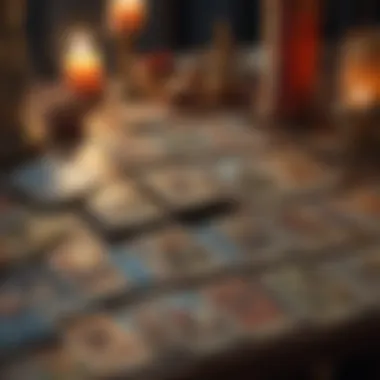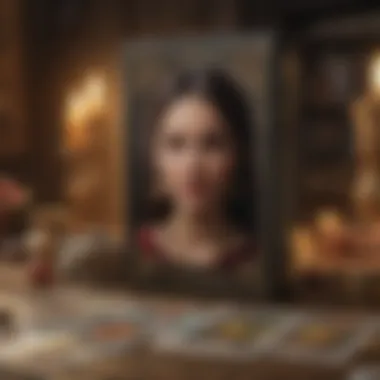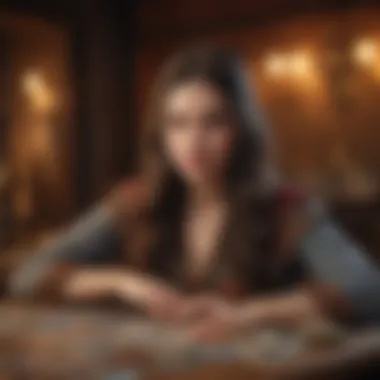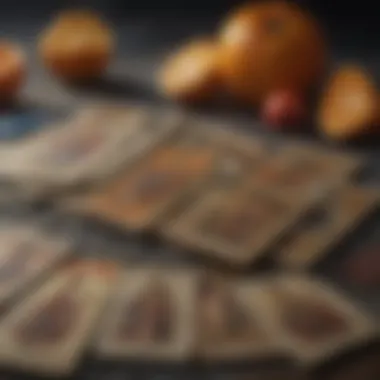Unlocking Insights: The 13 Card Tarot Spread Explained


Intro
The 13 card tarot spread has long been regarded as a powerful method for those seeking profound insights and reflection. By utilizing this spread, practitioners can derive significant personal growth and self-discovery. This portion of the article lays the foundation for understanding the essential components of the 13 card spread while highlighting its relevance in various personal contexts.
In this guide, we will explore not only the structure of the spread but also the intricate meanings behind each card's position. This can illuminate various aspects of an individual's life journey, providing clarity and direction.
Understanding the Zodiac
Tarot often aligns with the principles of astrology. Each card can relate to specific zodiac signs, enhancing the interpretive depth of readings. Understanding the underlying astrological connections can bolster the insights gained from the 13 card tarot spread.
Overview of Zodiac Signs
The zodiac consists of 12 distinct signs, each corresponding to different personality traits and life experiences. These signs are linked to the twelve houses of astrology, impacting areas such as relationships and career.
Sign Traits and Characteristics
Each zodiac sign exhibits unique traits:
- Aries: Assertive, enthusiastic, and impulsive.
- Taurus: Practical, reliable, and sensual.
- Gemini: Curious, adaptable, and communicative.
- Cancer: Nurturing, sensitive, and protective.
- Leo: Charismatic, confident, and dramatic.
- Virgo: Analytical, detail-oriented, and diligent.
- Libra: Diplomatic, charming, and relationship-focused.
- Scorpio: Intense, secretive, and transformative.
- Sagittarius: Optimistic, adventurous, and philosophical.
- Capricorn: Disciplined, ambitious, and responsible.
- Aquarius: Innovative, humanitarian, and independent.
- Pisces: Empathetic, artistic, and dreamy.
Elemental Qualities
Zodiac signs are further classified into four elemental categories:
- Fire: Aries, Leo, Sagittarius - passionate and spontaneous.
- Earth: Taurus, Virgo, Capricorn - grounded and pragmatic.
- Air: Gemini, Libra, Aquarius - intellectual and communicative.
- Water: Cancer, Scorpio, Pisces - emotional and intuitive.
Understanding these elemental qualities can provide further context when interpreting card positions within the 13 card tarot spread.
Prelude to Tarot Spreads
The exploration of tarot spreads serves as a foundational element in understanding the dynamics of tarot reading. This section delves into the essence of tarot spreads, providing context for the selected 13 card tarot spread. Spreads structure the reading process, guiding the reader and querent alike through a tapestry of meanings and interpretations. Their layout enables a coherent reflection on past, present, and future situations, thereby enhancing the efficacy of tarot as a tool for insight.
Understanding Tarot
Tarot is not merely a set of cards; it represents a complex system that intertwines symbolism, intuition, and personal reflection. Each tarot deck consists of 78 cards, divided into the Major and Minor Arcana. The Major Arcana cards reflect significant life themes and spiritual lessons, while the Minor Arcana offers insights into daily challenges and experiences. When engaging with tarot, practitioners can either seek direct guidance or use the cards for deeper self-discovery. The richness of tarot lies in the intricate interplay between the cards and the reader's intuition. Understanding this can open up new avenues for personal growth and insight.
The Role of Spreads
Spreads play a crucial role in organizing the reading process. Each position in a spread has a specific meaning, framing the cards in a context that can be more easily interpreted. The 13 card spread offers a comprehensive view, allowing for the exploration of multifaceted issues. For instance, one position may reveal obstacles, while another might suggest a pathway forward. The unique structure of this spread ensures that the querent receives a holistic reading that addresses both immediate concerns and broader life patterns. In essence, spreads transform the abstract art of card reading into a structured practice, empowering individuals through clarity and insight.
“A well-crafted spread is like a map, guiding the seeker through the landscape of their psyche.”
The Significance of the Card Spread
The 13 card tarot spread holds a position of importance within the broader context of tarot reading. It provides a structured yet flexible framework for interpretation, allowing both seasoned practitioners and newcomers to delve deep into the complexities of their lives. This spread reveals layers of meaning across various aspects, making it particularly beneficial for those seeking personal insight and clarity.
A central appeal of the 13 card spread lies in its comprehensive nature. Each card position has its own relevance, contributing to a holistic view of the querent's situation. The layout covers past influences, present realities, and potential future outcomes, creating a rich tapestry of understanding.


Additionally, the spread is adaptable. While its structure allows for consistency, the interpretations can vary based on the reader's intuition and the querent's unique circumstances. This adaptability ensures that readings are not rigid but rather resonate on a personal level.
Historical Context
To appreciate the significance of the 13 card spread, one must consider its historical roots within tarot. Tarot has evolved over centuries, originating in 15th century Europe as a card game before transitioning into a tool for divination and self-reflection. The use of complex spreads gained traction in the 19th century, coinciding with the rise of spiritualism and esoteric practices.
The 13 card spread has been influenced by various cultural and mystical traditions over time. Each card is imbued with its own history and symbolism, enriched by the collective insights of countless readers. This historical context provides legitimacy to the spread, grounding it within a lineage of wisdom.
Structure and Layout
The structure of the 13 card tarot spread is systematic yet offers flexibility. Typically, the cards are laid out in a specific sequence, each representing a different aspect of the querent’s inquiry. For example:
- Card 1: The Past - Examines what has led up to the current situation.
- Card 2: The Present - Reflects the current energies at play.
- Card 3: The Future - Offers insight into potential outcomes based on current trajectories.
The subsequent cards often delve into the emotional, spiritual, and practical ramifications of the situation, providing depth and nuance.
Understanding the structure allows readers to navigate the spread with purpose. Each card's position serves as a guide, helping to frame questions and shape the narrative of the reading. By recognizing the interplay between the cards, one can unlock deeper meanings, enhancing the overall reading experience.
The 13 card spread is not just a collection of cards; it is a journey of exploration and understanding, empowering those who embrace its insights.
Components of the Card Spread
The 13 card tarot spread is a complex but insightful method of tarot reading. Understanding its components is vital for practitioners who seek to utilize this tool effectively. Each card in the spread holds significance and represents a unique aspect of the reading. By grasping these elements, tarot readers can uncover deeper meanings and establish a more nuanced understanding of their inquiries.
Overview of Card Positions
In this spread, each position assigned to the cards corresponds to specific themes or life aspects. The arrangement of these cards allows for broad interpretations, relying on a mixture of positions related to time, circumstances, emotions, and challenges. Here are the primary roles of some significant card positions:
- Card One: The Past – This card helps to reveal influences from the past that shape the present.
- Card Two: The Present – It illustrates the current situation and the characteristics surrounding the querent’s life.
- Card Three: The Future – It highlights potential outcomes and future developments based on current trajectories.
- Cards Four to Thirteen – These positions delve into more intricate details, offering insight into relationships, personal growth, and external influences.
Understanding these positions enriches the reading. Knowing what each position represents allows tarot users to connect the dots between their inquiries and card meanings, leading to a cohesive narrative that informs decision-making processes and personal reflections.
Interpreting Card Meanings
Interpreting the meanings of the cards in the 13 card spread is as important as understanding their positions. Each card can convey a spectrum of messages, which vary according to context and positioning. Here are key factors to consider when interpreting card meanings:
- Card Symbolism – Tarot cards have intrinsic symbolism that provides layered meanings. For instance, the Tower card can represent sudden upheaval or revelation, depending on its position in the spread.
- Reversed Cards – When a card appears in its reversed position, its interpretation can shift significantly. This requires the reader to consider how the reversal affects the overall message.
- Card Relationships – The relationship between different cards can alter their meanings. Analyzing adjacent or related cards enables deeper insights into complex situations.
- Intuition – Tarot reading is not just academic; it also relies on the reader's intuition. Trusting one's instincts while interpreting card meanings is essential for creating a personal connection to the reading.
“The essence of tarot reading lies in balancing learned knowledge with one's instinctual responses to card placements and meanings.”
By integrating these interpretative strategies, readers can derive profound insights from each card, allowing the spread to serve as a catalyst for personal growth and understanding.
Detailed Card Position Analysis
The analysis of card positions within the 13 card tarot spread is crucial for understanding the overall reading. Each position serves a unique purpose, helping to create a narrative that connects the past, present, and future. Recognizing how these cards interact provides deeper insight into the querent's journey.
When conducting a tarot reading, understanding the significance of each card position can enhance the interpretative process. For example, cards placed in the past position reflect influences and experiences that shape the present. Conversely, cards in the future position suggest outcomes based on current paths or decisions.
Understanding each card's position allows for a nuanced view of the querent's life circumstances and emotional state.


Card One: The Past
The first card, representing the past, offers context for the reading. It often highlights key experiences or lessons learned that continue to impact the querent's life. This card may reveal not just past events but also ingrained patterns or thoughts that influence current behaviors. A careful interpretation of this position can uncover unresolved issues or lingering emotions that may need attention.
For instance, if the card drawn is the Six of Cups, it may indicate nostalgia or a longing for simpler times. This reflection can guide the querent in understanding why they may resist change or hold onto past relationships. Investigating past influences can be a powerful step in the healing process and in moving toward growth.
Card Two: The Present
Card two brings the reading to the present moment. It acts as a mirror, reflecting current circumstances and emotional states. Understanding this position is essential, as it reveals both the strengths and challenges facing the querent right now. This card can also highlight resources and opportunities available to the querent.
For example, if the card drawn is the Two of Swords, it may suggest internal conflict or indecision. This insight can prompt the querent to confront their current situation, pushing them toward resolution or clarity. Recognizing where they are in life is a crucial stepping stone to planning for the future.
Card Three: The Future
The third card focuses on the future, offering potential outcomes based on the current trajectory. This position does not predict a fixed outcome but rather suggests possibilities that can unfold depending on choices made. It encourages the querent to contemplate their desired path and the actions needed to arrive there.
If, for instance, the card drawn is the Fool, it signifies new beginnings and the potential for adventure. This evokes a sense of optimism, reminding the querent that they can forge a new direction. It emphasizes the importance of taking risks and being open to change in shaping future experiences.
Card Four to Thirteen: An Overview
Cards four to thirteen delve deeper into the nuances of the querent's experiences and future possibilities. Each of these positions has specific meanings, contributing layers to the reading. This holistic view allows the reader to address various aspects of life, including relationships, career, spiritual growth, and challenges.
For instance:
- Card Four: Influences - Examines external factors at play.
- Card Five: Obstacles - Identifies challenges that may arise.
- Card Six: Goals - Reflects the querent's aspirations.
- Card Seven: How Others See You - Explores perceptions and judgments.
- Cards Eight through Thirteen - Continue this pattern, offering insight into different life areas until the full picture emerges.
This sequential analysis leads to a more profound understanding of where the querent has been, where they are now, and where they might be heading. Recognizing these patterns can result in a transformative experience, guiding the querent toward self-awareness and action.
Practical Applications of the Card Spread
The 13 card tarot spread serves more than a mere function of card placement; it is a multifaceted tool that can lead to profound insights and revelations. Understanding its practical applications allows both novice and experienced readers to harness its full potential. The versatility of this spread makes it suitable for various situations, enabling users to tailor their approach based on personal needs or the nuances of a specific inquiry. This section will delve into how this spread can facilitate personal insight and how it can be effectively incorporated in tarot readings.
Using the Spread for Personal Insight
Personal insight through the 13 card spread goes beyond the superficial interpretation of individual cards. Each position within the spread reflects distinct aspects of the querent's life, allowing for a holistic evaluation of their circumstances. The spread prompts self-reflection, encouraging users to contemplate key areas such as:
- Emotion: Understanding emotions linked to past experiences and current challenges.
- Thoughts: Analyzing mental patterns that influence decision-making processes.
- Acceptance: Recognizing and accepting current situations or feelings in order to move forward.
Engaging deeply with each card's meaning can reveal hidden truths. This process can lead to significant personal revelations, paving the way for self-discovery. It is essential to approach each reading with an open mind and a willingness to confront uncomfortable truths. The insights gained from this spread can foster personal growth, as it encourages individuals to reflect on their life choices and motivations.
Incorporating the Spread in Readings
Implementing the 13 card spread in tarot readings involves several considerations. A well-structured reading can facilitate a comprehensive exploration of the querent's concerns. Here are key elements to consider when incorporating the spread:
- Preparation: Prior to the reading, establish a comfortable environment. Ensure you have a quiet space where the querent feels at ease.
- Question Formulation: Guide the querent to formulate specific questions or themes to focus on during the reading. This allows for a more tailored interpretation of the cards.
- Card Interpretation: As the cards are drawn, take time to examine each one in relation to its position. The meanings will often interconnect, providing a narrativ that addresses the querent's inquiry.
- Reflection: After interpreting the cards, encourage the querent to share their thoughts and reflections on the reading. This promotes an interactive experience, deepening the understanding of the insights revealed.
By incorporating the 13 card spread effectively, readers can enhance the depth of their tarot sessions. This approach not only provides clarity for querents but also cultivates an enriched participatory experience, making each reading unique.


Key Insight: The 13 card spread is less about predicting the future and more about illuminating the present, offering pathways for deeper understanding and growth.
Ultimately, the practical applications of the 13 card spread in tarot reading are vast. Engaging with both personal insight and effective integration into readings reinforces its significance as a valuable tool for exploring the self and addressing life's complexities.
Common Misconceptions about Tarot Spreads
Understanding the common misconceptions surrounding tarot spreads is essential for both practitioners and those exploring tarot reading. These myths can hinder one’s progress and lead to misunderstanding of the tools and their potential. Addressing these issues enhances clarity and builds a more informed approach to interpreting tarot cards.
Separating Fact from Fiction
One prevalent misconception is that tarot spreads can predict the future with certainty. While this is a widespread belief, it oversimplifies the purpose of tarot. Tarot should not be seen as a tool for predicting exact events. Rather, it offers insights into possible outcomes based on current circumstances and personal choices. Respecting this nuance creates realistic expectations for those engaging with tarot.
Another misconception involves the idea that only gifted individuals can effectively read tarot. This belief can discourage many potential readers. In actuality, tarot reading is a skill that can be cultivated through practice and study. The cards serve as mirrors reflecting the viewer's insights and intuitive understanding. Thus, learning to interpret tarot spreads is accessible to anyone dedicated to the craft.
Furthermore, some think that reading tarot must follow strict rules. While guidelines are critical, flexibility exists within tarot interpretations. Each reader may develop their unique style that respects traditional meanings while incorporating personal intuition. This personalized approach often yields richer insights.
“Tarot is not about knowing all the rules. It is about understanding the flow and trusting your intuition.”
Understanding the Role of Intuition
Intuition plays a significant role in tarot readings, yet it is often underestimated. Many newcomers believe that they must rely solely on textbook definitions of cards. However, developing one's intuitive abilities is crucial for meaningful interpretation. Each reader may feel these cards resonate differently, and this personal connection enhances readings.
Some may also assume that intuition is a mystical or inexplicable force. In reality, intuition encompasses one's own experiences, beliefs, and emotions. By acknowledging this aspect, readers can better connect with the messages that the cards communicate. Cultivating intuition involves practice and reflection, making it a skill that anyone can develop.
The interplay between structure and intuition is vital in tarot. While learning card positions and spreads is essential, allowing one's intuition to guide interpretations leads to profound realizations. This dynamic makes tarot a versatile tool for personal exploration and growth. Ensuring this balance will help dispel misconceptions and elevate the practice of tarot reading.
The Future of Tarot Reading
The world of tarot is continuously changing. As interest in tarot reading rises, so does the need for modern practices to adapt to contemporary life. Understanding the future of tarot reading is essential for those who wish to stay relevant and effective in their practice. New techniques and methodologies are emerging, influenced by cultural shifts and technological advancements. These factors play a significant role in shaping how tarot is perceived and utilized today.
Evolving Practices
Tarot practices have evolved significantly over the years. One major shift is in the approach to readings. Traditionally, tarot was often seen as a mystical art reserved for the few. However, today, there is a growing democratization of tarot. More people are engaging with tarot for personal insight rather than focusing solely on predictive outcomes.
This shift encourages flexibility in how tarot is used. Readers can experiment with different spreads, even combining elements from other divination systems. For instance, some practitioners blend tarot with astrology or numerology to create a richer tapestry of meaning. This integration fosters personalized readings that resonate deeply with individuals.
The community aspect of tarot is also changing. Interactive workshops and online courses are making it easier to share knowledge and experiences. As readers connect through social media platforms such as Facebook and Reddit, they exchange techniques and insights that enhance their practices.
Technological Influences
Technology is making a notable mark on tarot reading. Many practitioners now utilize apps and websites for readings. These digital tools can simulate traditional spreads, allow for easy access to card meanings, and facilitate learning for beginners. Furthermore, tarot apps often include features for daily draws and interpretation guides, which can enhance users' understanding and engagement with the cards.
Another aspect is the rise of virtual readings. Tarot readers are offering services through video calls, enabling them to reach a global audience. This accessibility allows for diverse interactions, fostering a sense of community despite geographical barriers.
Additionally, advancements in artificial intelligence are beginning to enter the tarot space. Some platforms use AI to generate readings based on user input. While this may not replace traditional reading, it reflects a blending of old and new. Readers may need to consider how these changes influence their practices and the validation of experiences for their clients.
Ending
The conclusion of this article summarizes the complexity and significance of the 13 Card Tarot Spread. This spread acts not just as a collection of card placements, but as a holistic tool for introspection and revelation. By analyzing the connections between the cards and their positions, individuals can uncover deeper facets of their lives.
One primary benefit of the 13 Card Spread is its comprehensive nature. Compared to simpler spreads, this configuration provides a broader perspective on questions posed during a reading. Each card's position serves a distinct purpose, allowing for a more nuanced interpretation. Here’s what to consider when using the spread:
- Depth of Insight: Each card narrates a part of the larger story, contributing to a full understanding of the situation.
- Personal Growth: The spread encourages self-reflection, prompting users to think critically about their choices and experiences.
- Adaptability: Practitioners can modify the spread to focus on particular aspects of life, ensuring its relevance to diverse questions.
Moreover, understanding the 13 Card Spread contributes to a greater appreciation of tarot as a personal exploration tool. It emphasizes that every reading is unique. Each interaction with the cards may not yield the same results and hence warrants careful consideration of their meanings in context.







